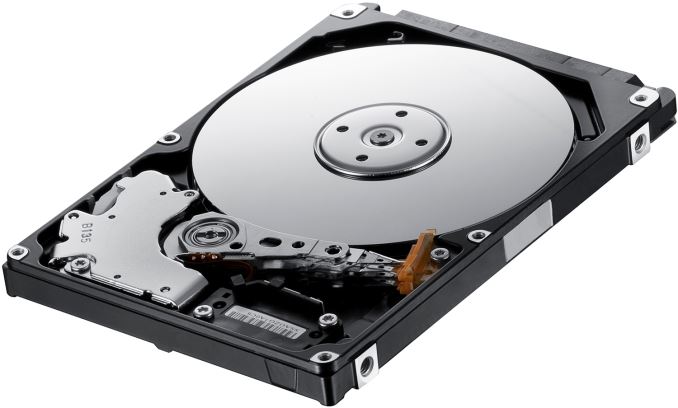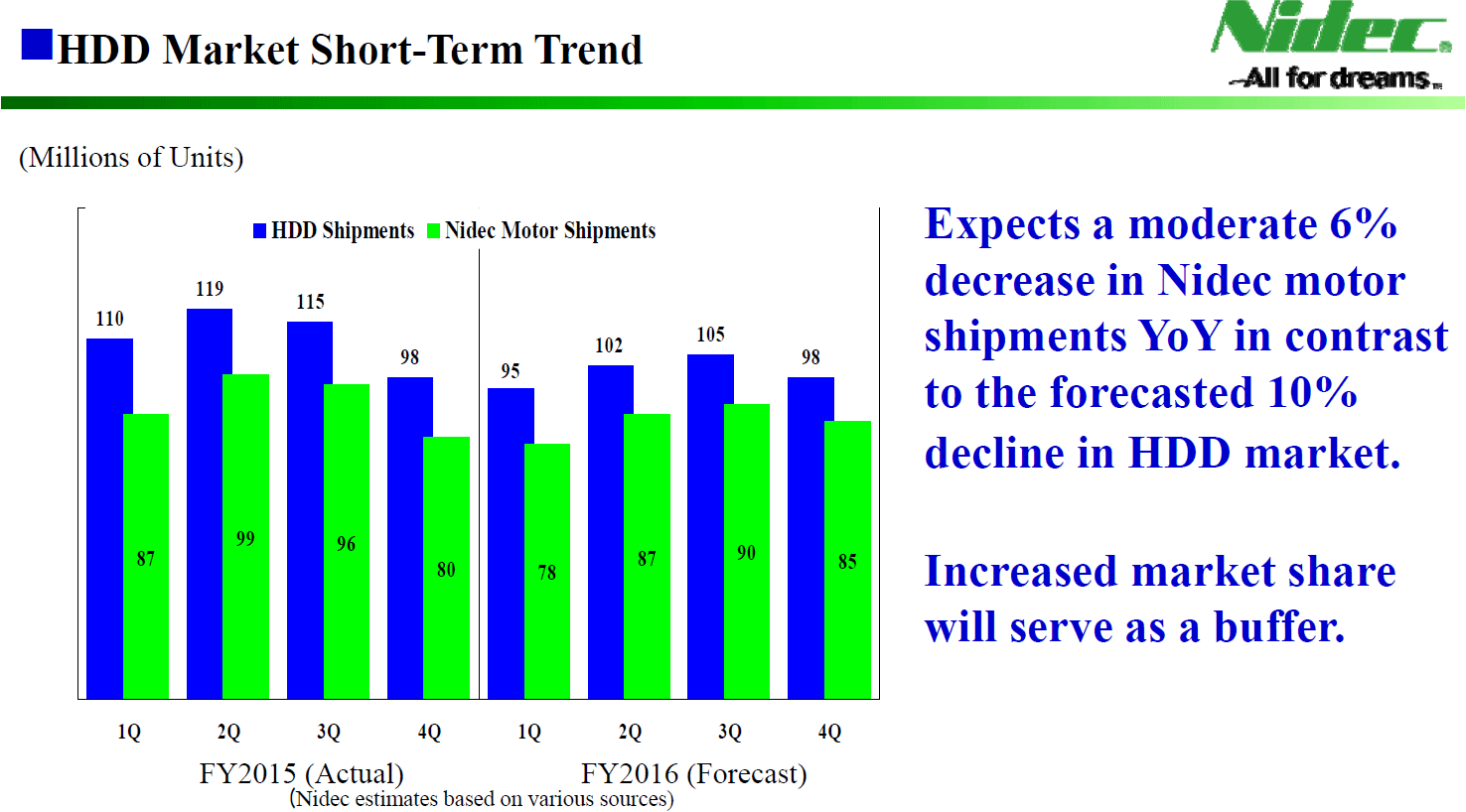Market Views: HDD Shipments Down 20% in Q1 2016, Hit Multi-Year Low
by Anton Shilov on May 12, 2016 8:00 AM ESTFinal Words
The storage market in the first quarter of 2016 performed in accordance with the PC market trends in general. Shipments of HDDs went down, but sales of high-capacity nearline hard drives remained a bright spot in the reports of leading hard drive suppliers. Western Digital remains optimistic in the short term for HDDs, but Seagate detailed plans to severely cut its production capacities and to reduce its presence the market of low-end mobile HDDs.
As ultra-thin notebooks, as well as 2-in-1 hybrid PCs, are gaining market share, the potential for 2.5” client HDDs suffers. Theoretically, sales of 2.5” drives for AIO and small form-factor desktops could offset declines in the mobile (at the expense of 3.5” HDDs declines), but this did not happen in Q1: sales of Seagate’s 2.5” client HDDs dropped to 10.6 million units (down 37% YoY), whereas shipments of Western Digital’s 2.5” client drives declined to 13.577 million units (down 28% YoY).
This quarter Seagate announced plans to discontinue some of its 2.5” low-capacity (500 GB and lower) client drives and concentrate on promoting 1 TB and 2 TB 2.5” models based on its latest technologies. Basically, Seagate no longer wants to compete against entry-level TLC NAND-based SSDs in low-end and mainstream notebooks. Reducing participation in this market segment will allow Seagate to simplify the portfolio of components it purchases from other makers and cut down its costs as high-capacity platters for advanced drives are made mostly in-house. It will be very interesting to see how other HDD makers respond to this action. They face similar problems and eventually it will only get harder to compete against cheap SSDs.
Shipments of 3.5” client hard drives hit a new low in the first three months of this year, which was not completely surprising, given slow shipments of PCs. So far neither Seagate nor Western Digital has announced plans to optimize their 3.5” lineups (WD actually folded its Green drives into its Blue lineup last year), but this is something that will likely happen in the future.
Enterprise HDD business is a mixed bag these days. On the one hand, sales of 10K and 15K HDDs are declining because of SSDs and that decline has yet to bottom out. Yet, those hard disks remain expensive and the business overall is profitable. On the other hand, sales of nearline drives are on the rise. More importantly, the growth of average capacities of such HDDs even outpaces the growth in their unit sales. Interestingly, Seagate indicated that demand for high-end 8 TB nearline HDDs was so strong in Q1 2015 that it could not even fulfill the orders placed. Seagate’s rather unexpected start of 10 TB HDD revenue shipments in April proves that operators of data center are rapidly building up capacities.
Seeing the fact that HDD sales volumes have been falling for many quarters now, Seagate not only decided to exit the market of low-end notebook drives but also detailed its plans to steeply cut-down its manufacturing capacities to 35 – 40 million units per quarter from 55 – 60 million units per quarter. From now on, the company will focus on high-capacity HDDs that are sold at higher prices rather than on affordable drives for bulk storage, which will naturally help it to avoid direct competition against SSDs in the entry-level segment where capacity may not be that important. It remains to be seen what Seagate will do with the manufacturing equipment that it will not need after its optimizations, but that is a different conversation entirely.
Looking ahead, Western Digital believes that the HDD TAM will remain above a psychologically important 400 million units per year mark (shipments of HDDs last year were around 453.6 million units), but will drop in the long term. Meanwhile, Nidec conservatively predicts that HDD TAM will fall to 400 million units in 2016 with shipments of PC and external HDDs declining the most. The upcoming quarters will show whether optimistic or conservative predictions are applicable to today’s HDD market.
Methodology and Important Notices
There are three major manufacturers of hard drives today: Seagate, Toshiba and Western Digital. Other suppliers are reselling hard drives made by these three companies.
Seagate and Western Digital reveal their HDD unit shipments as well as TAM (total available market) estimates every fiscal quarter. While such numbers are considered preliminary, they are usually rather accurate and re-affirmed by third-party analysts. Our TAM is the midpoint between Seagate’s and Western Digital’s TAM estimates. If only one hard drive maker reveals its TAM, we consider the number from only one vendor.
Meanwhile Toshiba does not officially disclose its HDD shipments. We subtract quarterly shipments of Seagate and Western Digital from our TAM estimate to get the number of drives sold by Toshiba. The approach is is the reason why we do not report historical shipments of Toshiba prior to Q3 2012. Based on estimates of hard drive makers and industry observers, Toshiba cannot produce more than 22 – 23 million of HDDs per quarter.
Seagate’s and Western Digital’s fiscal quarters end on the last business day of the last week of a calendar quarter (e.g., the Friday next to December 31). While fiscal quarters of HDD makers may not correspond exactly to calendar quarters, they are very close. Fiscal years of Seagate and Western Digital do not correspond to calendar years as they begin in July.
Historical TAM data comes from financial reports of Seagate and Western Digital.
Note 1: Seagate completed the acquisition of Samsung’s HDD business in December, 2011. The company started to include sales of Samsung-branded HDDs in its quarterly shipments in Q1 2012 (Q3 FY2012).
Note 2: Western Digital closed the acquisition of Hitachi Global Storage Technologies in March, 2012. Western Digital began to include HGST shipments in its financial reports in Q2 2012 (Q4 FY2012).
Note 3: Toshiba acquired some of Western Digital’s 3.5-inch HDD manufacturing equipment and intellectual property in May, 2012. It was expected that the manufacturing transfer could be complete within 6 to 12 months. Western Digital made HDDs for Toshiba on a contract basis until late Q4 2012. Due to the contract manufacturing agreement between Western Digital and Toshiba in 2012, there may be some inaccuracies in the historical data in that period (i.e., since the drives were made by Western Digital and then sold to Toshiba, they are attributed to the former, not the latter).
Note 4: Seagate defines client HDDs as 2.5” and 3.5” hard drives for desktops, notebooks and hybrid PCs as well as game consoles. Seagate considers HDDs for external storage and network-attached storage (NAS) as “branded” drives. Hard disks for DVRs and surveillance systems belong to Seagate’s family of HDDs for consumer electronics. Enterprise lineup includes 2.5” and 3.5” drives for mission critical (SAS, SCSI, Fibre Channel), enterprise storage, nearline and other datacenter applications.
Note 5: Western Digital attributes desktop and mobile 2.5” and 3.5” hard drives to client HDDs. External hard drives and NAS are referred to as “branded products”. Western Digital’s consumer electronics HDDs are used in DVRs, game consoles, video streaming applications and security video recording systems.












116 Comments
View All Comments
nandnandnand - Thursday, May 12, 2016 - link
Don't trust the cloud! It's meant to shackle and spy on you!Wolfpup - Thursday, July 14, 2016 - link
It's also way too slow, way too unreliable, and way, way, way too limited by bandwidth caps.tamalero - Tuesday, May 17, 2016 - link
Makes you wonder if most companies will just switch to corporate/business storage devices in the end. And leave the SSDs for consumer market.Achaios - Thursday, May 12, 2016 - link
I upgraded my Dec 2013 rig last mont.One of the upgrades, was replacing the two WD Green 2TB drives in Raid 1 I had with two WD Blue 6 TB drives also placed in Raid 1.
This will set me up for the next 5-6 years, so presumably I won't be buying any more HDD's until then.
My rig uses a Samsung 840 EVO 500 GB SSD as an OS/Games drive and a Samsung 750 120GB SSD (upgrade) as an emergency boot drive/virtual memory drive.
I think I am all set until the next major upgrade event. Don't think I will be buying any more storage (SSD or HDD) for the next 5 years or so.
bill.rookard - Thursday, May 12, 2016 - link
Agreed. I just updated my NAS with some 4TB enterprise drives (3x4TB in RAID5) and retired my 5x2TB RAID5 array. Same overall size, but vastly increased reliability and I should be good for a few years.Meanwhile all my new builds are SSD based.
TheinsanegamerN - Thursday, May 12, 2016 - link
SSDs are big enough now that most users dont need HDDs anymore.Even for gamers, the richer ones can afford all SSD storage. My laptop has a 256 and 512GB SSDs in it, and I feel no squeeze for space, just install the games you actually play. And if more space is needed, 2TB SSDs exist now. I doubt many gamers need more than 2TB of games downloaded at any one point.
Which leaves media creation and one of the few that still need HDDs, although that may change. Outside of backup devices, HDDs dont have much of a future in consumer devices.
DanNeely - Thursday, May 12, 2016 - link
Agreed; however the problem is that most consumers don't understand that SSDs will make their laptop much more responsive; and that the lack of spinning rust is the biggest reason why their phone and tablet are so much more responsive. 3/4ths of PCs are still crippled with HDDs and sold to customers who only understand two numbers: Total price, less is always better here. Number of GB, more is always better here. If they don't actually need the disk space, and most don't, they're wrong about the latter; but you can't fight ignorance at the boxmart.Just checking prices for new name brand laptop HDDs on Newegg shows the price margin between 1TB drives and smaller ones has almost completely vanished: 250 GB, $39; 320 GB, $45, 500 GB, $45; 1TB $52; 2 TB, $94. Just based on how far 1 TB laptop drives have dropped in price I'm not surprised that Seagate's discontinuing their smaller capacity drives; WD and Toshiba will probably end up doing the same within a year.
At the same time the cheapest ~960GB SSD on Newegg is still $200, with $50 only getting you 240GB. That's enough of a price/capacity gap to keep the majority of the clueless with legacy storage for at least a few more years.
TheinsanegamerN - Thursday, May 12, 2016 - link
Very true, but the kind of people that dont understand SSDs are probably the same kind of people that want the most GBs because they think it will make the computer faster. Nothing will help them I'm afraid.But then, the cheap junk they usually buy gets the scrap parts anyway, the good lines of HDDs always went into business machines and stuff with a higher margin. That market is falling in love with SSDs very quickly.
FunBunny2 - Thursday, May 12, 2016 - link
-- But then, the cheap junk they usually buy gets the scrap parts anyway, the good lines of HDDs always went into business machines and stuff with a higher margin.and the same thing is happening in the SSD space.
DanNeely - Thursday, May 12, 2016 - link
Technically illiterate customers looking at the only number they think they understand and wanting HDDs was my point. Excluding those willing to pay a little extra for a stylish thin laptop I don't see that changing any time soon because the price per GB difference is still way too large.